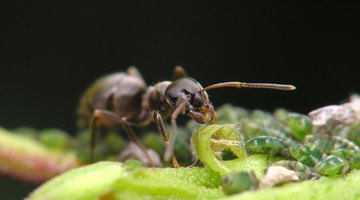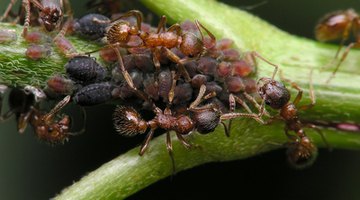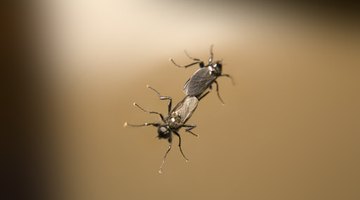The hibiscus or Chinese hibiscus (Hibiscus rosa-sinensis) is originally from China; it is now one of the most widely cultivated tropical plants in the world. It is grown for its showy, colourful flowers, which are up to 6 inches across. Hibiscus plants can be grown outdoors in areas with minimum temperatures of above -1.11 degrees Celsius; they also make good houseplants in colder zones. Hibiscus plants are vulnerable to attack from a number of black pests, including ants, aphids, thrips and gnats.
Ants

Ants are attracted to the nectar produced by hibiscus flowers, and bring aphid eggs with them when they show up. The ants feed on honeydew, a sweet substance produced by aphids, and actually protect the aphid colonies. Ants can be controlled with insecticide sprays or with poisonous bait that the ants take back to their colonies.
Aphids

Aphids are small, soft-bodied insects about the size of a pinhead. They can be green or brown as well as black. Aphids form colonies on the leaves and young stems of hibiscus plants and feed on sap, using their piercing mouth parts. They can spread leaf-deforming viruses to hibiscus plants, as well as encouraging the growth of sooty mould with their production of honeydew. Aphids can be controlled with a spray containing insecticidal soap or horticultural oil, or with an insecticide such as dimethoate.
- Aphids are small, soft-bodied insects about the size of a pinhead.
- They can spread leaf-deforming viruses to hibiscus plants, as well as encouraging the growth of sooty mould with their production of honeydew.
Thrips
Thrips are tiny, elongated insects less than 1/16 inch long. They can be yellow or brown as well as black. Thrips can be identified by the silvery patches they leave on hibiscus leaves. They also cause bud drop and deformed flowers. Treat thrip-infested hibiscus plants with a spray containing horticultural oil or insecticidal spray. Adults thrips can be trapped on pale blue or yellow sticky traps.
- Thrips are tiny, elongated insects less than 1/16 inch long.
- Adults thrips can be trapped on pale blue or yellow sticky traps.
Fungus Gnats

Black fungus gnats are commonly found around potted and indoor hibiscus plants. Their larvae live in soil and feed on fungus and rotting organic matter. Adult fungus gnats are harmless to hibiscus plants, but their presence in the home can be unpleasant. Adults can be trapped on sticky cards and the larvae treated with a soil drench containing neem oil.
- Black fungus gnats are commonly found around potted and indoor hibiscus plants.
- Adult fungus gnats are harmless to hibiscus plants, but their presence in the home can be unpleasant.
